Posted: November 17th, 2015 | No Comments »
By 1932 China was really getting on the airline map – 15,000 miles in 120 hours had been done – Moscow-Kamchatka so now onwards to a Shanghai-Moscow service by April – Comintern spies going one way and Chinese communists needing training must have been delighted!!
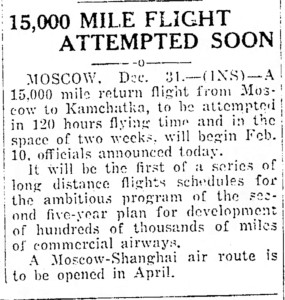
Posted: November 16th, 2015 | No Comments »
Issue 29 of the Asia Literary Review is out now (in e-form or paper copy by subscription or via amazon) – It includes plenty as usual (see below) including a piece by me on the rooftops of old Shanghai – a bit of a flaneur across the skyline of 1930s Shanghai through the war, revolution and into the 1990s….for everything that’s in the issue go here
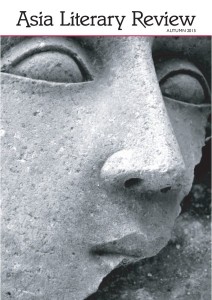
Posted: November 15th, 2015 | No Comments »
Empire of Tea is the latest addition to the literature on the history of tea…which would fill quite a few shelves now….

Tea has a rich and well-documented past. The beverage originated in Asia long before making its way to seventeenth-century London, where it became an exotic, highly sought after commodity. Over the subsequent two centuries, tea’s powerful psychoactive properties seduced British society, becoming popular across the nation from castle to cottage. Now the world’s most popular drink, tea was one of the first truly global products to find a mass market, with tea drinking now stereotypically associated with British identity. Imported by the East India Company in increasing quantities across the eighteenth century, tea inaugurated the first regular exchange between China and Britain, both commercial and cultural. While European scientists struggled to make sense of its natural history and medicinal properties, the delicate flavour profile and hot preparation of tea inspired poets, artists and satirists. Becoming central to everyday life, tea was embroiled in controversy, from the gossip of the domestic tea table to the civil disorder occasioned by smuggling, and the political scandal of the Boston Tea Party to the violent conflict of the Anglo-Chinese Opium War. Such stories shaped the contexts for the imperial tea industry that later developed across India and Sri Lanka. Empire of Tea is based on extensive original research, providing a rich cultural history that explores how the British ‘way of tea’ became the norm across the Anglophone world.
Posted: November 14th, 2015 | No Comments »
Here we see confiscated opium being burnt in Shanghai in 1931. I have read elsewhere that the special furnaces, overseen by the customs and police, were in Pootung (Pudong) and that convicted smugglers and other prisoners were used to do the job of hauling the dope into the brick built furnaces as part of their sentence. Apparently if the wind was in the right direction the sweet smell of the burning opium would waft across the Whangpoo into the International Settlement!!
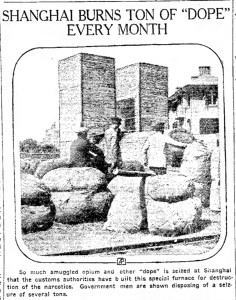
Posted: November 13th, 2015 | No Comments »
Neutral in World War Two, Portugal sought to project itself through the Exhibition of the Portuguese World, which opened in 1940 and continued on through 1941 in Belém, Lisbon. Apparently three million visitors passed through the turnstiles.If popular fiction about Lisbon at the time is to be believed most were probably spies swapping secret documents….

The exhibition was inaugurated on June 23 of 1940 by the Head of the Portuguese State, Marechal Carmona and the soon to be dictator Oliveira Salazar, who held the position of President of the Council (and soon to become head of the whole country).
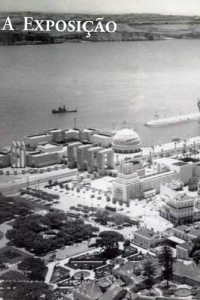
Macau was a big deal at the exhibition – the guide book for the exhibition mentions “Macau Road” – ‘Turning right and going downhill, you follow the Macau Road on which has been recreated a busy street typical of the Portuguese city in China.’ Macau Road was close to similar exhibits on Timor and Mozambique. This is all now the Garden of Ultramar and the entrance to the Road still exists…
 Nearby a “Colonial Restaurant” served typical meals prepared by Chinese and African cooks. Within Macau Road was also a permanent exhibition of the works of the painter Chiu Shiu Ngon. Now the source I saw may have the name wrong, but I can’t find any references to this painter – so if anyone knows anything do let me know….
Nearby a “Colonial Restaurant” served typical meals prepared by Chinese and African cooks. Within Macau Road was also a permanent exhibition of the works of the painter Chiu Shiu Ngon. Now the source I saw may have the name wrong, but I can’t find any references to this painter – so if anyone knows anything do let me know….
Posted: November 12th, 2015 | No Comments »
This exhibition is displayed within a shipping container on Bristol’s dockside outside M Shed café…
12 November—22 November 201; 10am-5pm; free
A Trading Journey

A contemporary photographic exhibition looking at the relationship between trading activities and their environment in Guangzhou, China – Bristol’s twin city.
Guangzhou (Canton) has been an important point of contact between China and Europe since the early eighteenth century with all foreign trade restricted to just this port city.
Inspired by themes that emerge from within the 34,000 images digitised by the ‘Historical Photographs of China’ project, Bristol based photographer Alejandro Acin has photographed some of the most important markets in Guangzhou. The aim was to create a visual narrative based on the routine trading activities of market traders and their relations with their environment.
The exhibition will be displayed within a shipping container on the city’s dockside linking to Bristol’s own trading past.
The project is part of the AHRC-funded British Inter-university China Centre’s cultural engagement activities.
More here
Posted: November 11th, 2015 | No Comments »
Late 1933 was a troubled time in Shanghai. The city was still effectively clearing up after the January 28th Incident (or the First Sino-Japanese War) in 1932. That battle had seen the first aerial bombing of civilian targets – five years before Guernica. The main damage was to the northern train station, Hongkew and other areas north of Soochow Creek meaning severe bomb, and resultant fire, damage both in the northern portions of the International Settlement and outwith in portions of Chinese-controlled Shanghai beyond Hongkew.
Over a year later Henry Moon (known to his friends as Harry) was found dead, shot through the heart, on the Kiangwan Road (now the Jiangwan Road). Kiangwan Road was largely settled by foreigners, though was technically outside the boundaries of the International Settlement to the north, in the so-called Northern External Roads between the railway line and Hongkew Park (now Lu Xun Park). Foreign police did venture up there and the Shanghai Municipal Council partially supplied gas and electric. There were no immediate clues as to who had shot him or why.
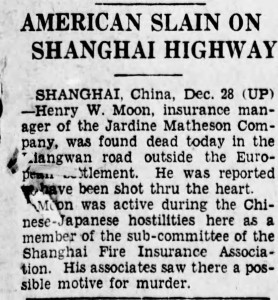
However, Henry Moon was a man of some importance in the aftermath of the 1932 attack on the city. Erroneously described as an American in this newspaper article, he was in fact (i’m pretty sure) from London. He was the insurance manager for Jardine Matheson, one of the largest insurers of property, commercial and residential, in the city. During the hostilities of 1932 he was on the sub-committee of the Shanghai Fire Insurance Association which represented all 142 foreign insurance companies operating in Shanghai (76 British, 19 American and 16 Japanese and a few others) and based itself on the rules established by the Fire Offices’ Committee of London. Under the so-called War Risks Clauses of most Shanghai insurance policies the Association refused claims totaling millions of dollars in the aftermath of the fighting. Naturally a large number of property owners were not happy.
To fight this decision an Association of Fire Insurance Claimants was formed by Yu Hsia-ch’ing, President of the Shanghai Chamber of Commerce and a well-known organiser of anti-Japanese boycotts in the city in 1931. Following the example of Henry Moon and his association, the Chinese courts in the city dismissed insurance claims with Chinese firms citing the war clauses argument. This meant a whopping $73,500 (Mexican) in claims was thrown out of court. There were demands for reparations made upon Japan for destroyed property, but Tokyo never responded to this appeals.
So who killed Henry Moon? Who disliked him enough to follow him or lure him out to Kiangwan Road and shoot him straight through the heart, presumably killing him instantly. Well, take your pick – 25% of Shanghai factories were damaged in some way by the war of 1932; half of those totally and many small businesses never recovered and saw their owners bankrupted as they couldn’t get an insurance payout. When the Chinese Courts followed the lead of the foreign Association 4,200 Chinese claimants saw their own claims with Chinese insurers rejected. And that’s an awful lot of suspects!!
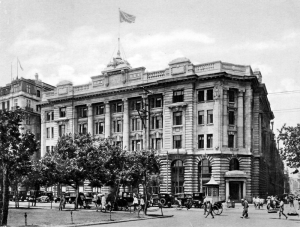
The Jardine Matheson building at No.27 Bund, the location of Henry Moon’s office in 1933.
Posted: November 10th, 2015 | No Comments »
Of course we saw similar headlines in the 1990s and 2000s – not so much today….this news in from 1931…










